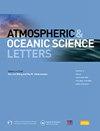海洋波谱对 Ku 波段偏振双向反射分布函数矩阵的影响及其对卫星后向散射模拟的影响
IF 3.2
4区 地球科学
Q3 METEOROLOGY & ATMOSPHERIC SCIENCES
引用次数: 0
摘要
基于双尺度粗糙度理论,建立了极化双向反射分布函数(pBRDF)矩阵,为海洋-大气耦合辐射传输模型提供更精确的微波发射和散射模拟。探讨了pBRDF矩阵在ku波段模拟海洋后向散射的潜力。研究了改进的Durden和Vesecky (DV2)、Elfouhaily和Kudryavtsev谱对pBRDF矩阵后向散射模拟的影响。此外,还分析了ku波段地球物理模型函数与pBRDF矩阵在后向散射归一化雷达截面(NRCS)模拟中的差异。结果表明,pBRDF矩阵能较好地再现海面后向散射能量的空间分布,但分布格局和数值受海浪谱的影响较大。除入射角小于35°、风速小于10 m s−1、横风向等情况外,DV2谱线是pBRDF矩阵模拟水平极化nrcs的最佳谱线。此外,DV2频谱有效地表征了垂直极化nrcs的风速和相对方位角依赖关系。Elfouhaily谱适用于低风速(小于5 m s−1)和入射角小于40°条件下的垂直极化nrcs模拟。Kudryavtsev谱在高入射角(>;40°)和低入射角(<;35°)。摘要为提供微波海洋——大气耦合辐射传输模型所需的精确发射和散射,基于双尺度粗糙度理论发展了极化双向反射分布函数(pBRDF)矩阵。本研究探讨了pBRDF矩阵是否能够表征ku波段洋面后向散射,对比了三种常用海浪谱模型对pBRDF矩阵后向散射模拟的影响,分析了ku波段地球物理模型函数(GMF)与pBRDF矩阵在后向散射归一化雷达截面(nrc)模拟中的差异。结果表明,pBRDF矩阵能够准确再现洋面后向散射能量的空间分布,但后向散射能量分布受海浪谱影响较大。本文章由计算机程序翻译,如有差异,请以英文原文为准。
Effects of ocean wave spectra on the polarized bidirectional reflectance distribution function matrix at Ku‐band and its implications on satellite backscattering simulations
A polarized bidirectional reflectance distribution function (pBRDF) matrix is developed from two-scale roughness theory with the aim of providing more accurate simulations of microwave emissions and scattering required for ocean–atmosphere coupled radiative transfer models. The potential of the pBRDF matrix is explored for simulating the ocean backscatter at Ku-band. The effects of ocean wave spectra including the modified Durden and Vesecky (DV2), Elfouhaily, and Kudryavtsev spectra on the pBRDF matrix backscatter simulations are investigated. Additionally, the differences in backscattering normalized radar cross-section (NRCS) simulations between the Ku-band geophysical model function and pBRDF matrix are analyzed. The results show that the pBRDF matrix can reasonably reproduce the spatial distribution of ocean surface backscattering energy, but the distribution pattern and numerical values are influenced by ocean wave spectra. The DV2 spectrum is the best one for the pBRDF matrix to simulate horizontally polarized NRCSs, with the exception of scenarios where the incidence angle is below 35°, the wind speed is less than 10 m s−1, and in the cross-wind direction. Also, the DV2 spectrum effectively characterizes the wind speed and relative azimuth angle dependence for vertically polarized NRCSs. The Elfouhaily spectrum is suitable for simulating vertically polarized NRCSs under conditions of low wind speed (below 5 m s−1) and incidence angles under 40°. The Kudryavtsev spectrum excels in simulating vertically polarized NRCSs at high incidence angles (> 40°) and horizontally polarized NRCSs at low incidence angles (< 35°).
摘要
为提供微波海洋-大气耦合辐射传输模型所需的精确发射和散射, 基于双尺度粗糙度理论发展了极化双向反射分布函数 (pBRDF) 矩阵. 本研究探讨了pBRDF矩阵是否能够表征ku波段洋面后向散射, 对比了三种常用海浪谱模型对pBRDF矩阵后向散射模拟的影响, 分析了ku波段地球物理模型函数 (GMF) 与pBRDF矩阵在后向散射归一化雷达截面 (NRCS) 模拟中的差异. 结果表明, pBRDF矩阵能够准确再现洋面后向散射能量的空间分布, 但后向散射能量分布受海浪谱影响较大.
求助全文
通过发布文献求助,成功后即可免费获取论文全文。
去求助
来源期刊

Atmospheric and Oceanic Science Letters
METEOROLOGY & ATMOSPHERIC SCIENCES-
CiteScore
4.20
自引率
8.70%
发文量
925
审稿时长
12 weeks
 求助内容:
求助内容: 应助结果提醒方式:
应助结果提醒方式:


